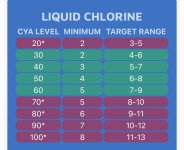We are instructed to keep the 'Cover Off' for 5, 10, 15, 20, mins after chemicals are added while the 1-2 pumps are circulating to allow for the initial high off gassing period. Is it just Chlorine and Dichlor that this is important for (w/ a chlorine tub) to lessen gas damage to the underside of the cover? Or is it just as important when adding the occasional .5 to 1 oz of Mur. Acid 31.45% also? For the Bromine folks, is the answer the same?
Because I do not have my cover lifter installed yet, I have usually just opened the cover half way while running the pumps to circulate 1-2 oz. of added chlorine.
1) If you leave just half the cover open for the recommended time, is that just as good for cover life protection as all the way off?
2) Does the fact that the water's off gassing flows by and over half of the under side of the cover on its way out, constitute a noticeable ill effect on the underside of that half of the cover?
3) Is the fact that the gasses flow out and away, and are not trapped in a cloud between the water's surface and the cover perfectly fine for the cover. With the cover closed, I'd assume the trapped gas builds in strength and deterioration, harmfulness to the cover.
4) If in fact, having the cover only half open is unlikely to cause deterioration for the closed half of the cover, would just leaving one end of the cover held open, say 4", allowing the gasses to escape, be just a good as either half off or completely off?
Occasionally I forget I have the hot tub cover off or half off for hours after adding chemicals... Ooooops. IDK if a half open cover or a cover with say just one end propped open say 4" or so, would lose any less heat than the cover all the way off, but my mind feels more guilty if I left it all the way off for a long period.
Thanks for your thoughts.
Because I do not have my cover lifter installed yet, I have usually just opened the cover half way while running the pumps to circulate 1-2 oz. of added chlorine.
1) If you leave just half the cover open for the recommended time, is that just as good for cover life protection as all the way off?
2) Does the fact that the water's off gassing flows by and over half of the under side of the cover on its way out, constitute a noticeable ill effect on the underside of that half of the cover?
3) Is the fact that the gasses flow out and away, and are not trapped in a cloud between the water's surface and the cover perfectly fine for the cover. With the cover closed, I'd assume the trapped gas builds in strength and deterioration, harmfulness to the cover.
4) If in fact, having the cover only half open is unlikely to cause deterioration for the closed half of the cover, would just leaving one end of the cover held open, say 4", allowing the gasses to escape, be just a good as either half off or completely off?
Occasionally I forget I have the hot tub cover off or half off for hours after adding chemicals... Ooooops. IDK if a half open cover or a cover with say just one end propped open say 4" or so, would lose any less heat than the cover all the way off, but my mind feels more guilty if I left it all the way off for a long period.

Thanks for your thoughts.


